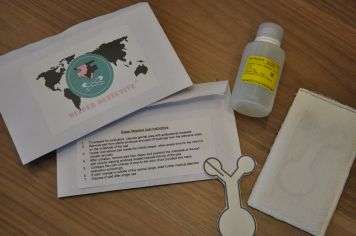Diaper pad to detect dehydration and bacterial infections in infants

A team of University of California, Riverside Bourns College of Engineering students created an inexpensive pad that can be inserted into diapers to detect dehydration and bacterial infections in infants.
The product, which recently won an award that included a $10,000 prize at a national engineering design contest, operates much like a home pregnancy test or urine test strip. Chemical indicators change color when they come in contact with urine from an infant who is suffering from dehydration or a bacterial infection.
The pad, which is 2.5 inches by 5 inches and called "The Diaper Detective," is attractive for numerous reasons. It costs 34 cents to make. It doesn't require electricity, cold storage or an advanced education to interpret. It's customizable so that other chemical indicators can be added to test for other medical conditions. And it could be adapted to be used in adult diapers.
"We created this to fulfill a need for a versatile, inexpensive, non-invasive method of urine collection in developing countries and elsewhere," said Veronica Boulos, one of the team members. "The beauty of this is that it solves a huge problem with simplicity."
Strike against infant mortality
The Diaper Detective addresses the worldwide problem of infant mortality in developing nations. Of the estimated 3.9 million annual neonatal deaths, 98 percent occur in developing countries and could be prevented with access to low cost, point-of-care diagnostics.
In developing countries, the students hope the Diaper Detective will be distributed via relief organizations. In the United States, the students believe the pad would qualify for reimbursement through medical insurance, making it an inexpensive option for low-income users.
The uniqueness of the diaper insert comes from the use of lateral flow channels that guide the user's urine to the reactive regions where the color change takes place. The lateral flow channels were originally created using Crayola crayons and are now created by paraffin wax and a laser printer.
The students won a third place award at the National Institute of Biomedical Imaging and Engineering Design by Biomedical Undergraduate Teams Challenge. They have also submitted the product to the National Collegiate Inventors and Innovators Alliance BMEStart competition.
Commercialization plans
The students have a patent pending on their concept and are in talks with industry about potentially commercializing the product.
The only other similar product they have found is the Pixie Scientific Smart Diaper. It is different in that it uses a QR patch on the diaper that gets scanned with a smartphone and then analyzed by an app for signs of urinary tract infections, dehydration and developing kidney problems.
The students also tested the colorimetric readouts using blinded participants. For dehydration, 99 percent correctly identified a negative result, meaning no color change, and 100 percent correctly identified a positive result, meaning a color change. For bacterial infection, 82 percent of participants correctly identified a negative result and 55 percent correctly identified a positive result.

The students believe the bacterial infection percentages were lower because of exposure to outside air. With an improved design, which they would model after what is used for urine dipsticks, they believe the percentages will improve.
The Diaper Detective team consists of Boulos, Melissa Cruz, Sara Said, Stephanie Tehseldar and Claire Tran. All are bioengineering majors. All, with exception of Tran, graduated in August. Tran expects to graduate in June 2015.
They are advised by William Grover, an assistant professor of bioengineering. They also were assisted by B. Hyle Park, also an assistant professor of bioengineering, who teaches the senior design class where the Diaper Detective project was developed.
Grover, who has three young children, was enthusiastic about the students' invention, in part because he witnessed one of his boys undergo a painful urinary catheterization, a current method to test the urine of infants.
"It's nice that there is a first world benefit so my son wouldn't have to be catheterized, plus a third world benefit because the pad is so simple to use and inexpensive to manufacture," Grover said.
Provided by University of California
















